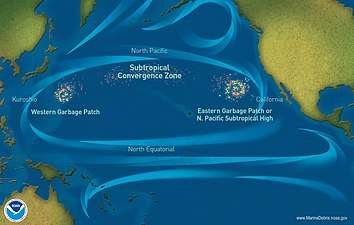Overconsumption
Overconsumption is a situation where resource use has outpaced the sustainable capacity of the ecosystem. A prolonged pattern of overconsumption leads to environmental degradation and the eventual loss of resource bases.
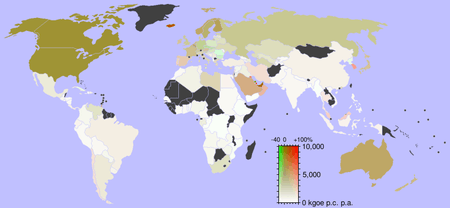
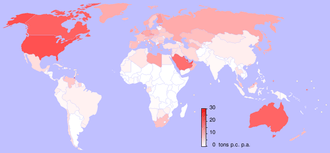
Generally, the discussion of overconsumption parallels that of human overpopulation;[1] that is the more people, the more consumption of raw materials takes place to sustain their lives. However, humanity's overall impact on the planet is affected by many factors besides the raw number of people. Their lifestyle (including overall affluence and resource utilization) and the pollution they generate (including carbon footprint) are equally important. Currently, the inhabitants of the developed nations of the world consume resources at a rate almost 32 times greater than those of the developing world, who make up the majority of the human population (7.4 billion people).[2]
However, the developing world is a growing market for consumption. These nations are quickly gaining more purchasing power and it is expected that the Global South, which includes cities in Asia, America and Africa, will account for 56% of consumption growth by 2030.[3] This means that consumption rates will plateau for the developed nations and shift more into these developing countries.
The theory of overpopulation reflects issues of carrying capacity without taking into account per capita consumption, by which developing nations are evaluated to consume more than their land can support. The United Nations estimate that world population will reach 9.8 billion in the year 2050 and 11.2 in 2100.[4] This growth will be highly concentrated in the developing nations which also poses issues with inequality of consumption. The nations that will come into consumer dominance must abstain from abusing certain forms of consumption, especially energy consumption of CO2.[5] Green parties and the ecology movement often argue that consumption per person, or ecological footprint, is typically lower in poorer than in richer nations.
Causes
There is a spectrum of goods and services that the world population constantly consume. These range from food and beverage, clothing and footwear, housing, energy, technology, transportation, education, health and personal care, financial services and other utilities.[6] Each of these require a different resource and once that resource is exploited to a certain point, that qualifies as overconsumption. Since the developing nations are rising quickly into the consumer class, it is important to note the trends happening in these nations. According to the World Bank, the highest shares of consumption lie in food, beverage, clothing, and footwear. This applies regardless of the sector of income.[6]
Two main factors of why people buy so much and so often are due to planned and perceived obsolescence.[7] This factor of production was introduced first in the United States and it revolves around the design of products. With these methods, the products are intentionally designed to be discarded after a short amount of time. As of 2012, only 1% of goods purchased were still in use after 6 months. When it is planned, designers create products that will not be able to work after a certain amount of time but they work for enough time to ensure the customers will come back to buy again. Perceived obsolescence comes in a lot with fashion and trends and fueled by advertising and media consumption. Through this technique, consumers are convinced that certain products do not have value anymore because it is out of style, and to have value, consumers must buy more up to date styles. As of 2015, the top five consumer markets in the world included the United States, Japan, Germany, China and France.[8]
Effects
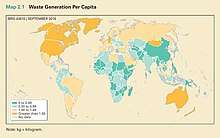
A fundamental effect of overconsumption is a reduction in the planet's carrying capacity. Excessive unsustainable consumption will exceed the long term carrying capacity of its environment (ecological overshoot) and subsequent resource depletion, environmental degradation and reduced ecosystem health.
Looking at the two largest sectors of over consumption, the fashion and food industries, we can see most of the harmful effects on the Earth starting here. The fashion industry has created a new venue, fast fashion, which in 2013 produced 15.1 million tons of textile waste and of that, 12.8 million tons were thrown out. The United States, being the largest consumer market, deals with excess clothing by exporting it to poorer, developing nations but this solution is not sustainable because the demand will go down as cheap clothing becomes more readily available. Another way of disposal is to throw out into landfills or burn up in incinerators which is the least sustainable disposal solution.[9]
The food industry is the other largest sector of consumption and studies show that people waste a fifth of food products just through disposal or overconsumption. The UN Food and Agriculture Organization collected data and found that by the time food reaches the consumer, 9% (160 million tons) goes uneaten and 10% is lost to overconsumption - meaning consumers ate more than the calorie intake requirement. Other aspects of losses surrounding dry matter came at each stage in the food system, the highest amount being from livestock production at 43.9%, transportation accounted for 18% and consumer waste accounting for 12.2% loss. When the consumer takes in too much, this not only explains losses at the beginning of the stage at production (and overproduction) but also lends itself to overconsumption of energy and protein, having harmful effects on the body.[10]
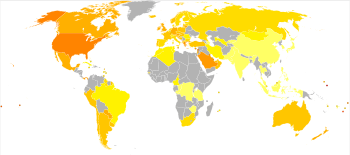
The scale of modern life's overconsumption has enabled an overclass to exist, displaying affluenza and obesity.[11] However once again both of these claims are controversial with the latter being correlated to other factors more so than over-consumption. Within the topic of overconsumption, many other ideas should be considered to find the true cause of it. Some important events that coincide are poverty, population and the development of an area.[12] Overconsumption can also lead to a decline in the economy and financial instability.[13]
In the long term, these effects can lead to increased conflict over dwindling resources[14] and in the worst case a Malthusian catastrophe. Lester Brown of the Earth Policy Institute, has said: "It would take 1.5 Earths to sustain our present level of consumption. Environmentally, the world is in an overshoot mode."[15]
As of 2012, the United States alone was using 30% of the world's resources and if everyone were to consume at that rate, we would need 3-5 planets to sustain this type of living. Resources are quickly becoming depleted, with about ⅓ already gone. With new consumer markets rising in the developing countries which account for a much higher percentage of the world's population, this number can only rise.[7] According to Sierra Club’s Dave Tilford, "With less than 5 percent of world population, the U.S. uses one-third of the world’s paper, a quarter of the world’s oil, 23 percent of the coal, 27 percent of the aluminum, and 19 percent of the copper."[16] According to BBC, a World Bank study has found that "Americans produce 16.5 tonnes of carbon dioxide per capita every year. By comparison, only 0.1 tonnes of the greenhouse gas is generated in Ethiopia per inhabitant."[17]
Economic growth
The Worldwatch Institute said China and India, with their booming economies, along with the United States, are the three planetary forces that are shaping the global biosphere.[18] The State of the World 2005 report said the two countries' high economic growth exposed the reality of severe pollution. The report states that
The world's ecological capacity is simply insufficient to satisfy the ambitions of China, India, Japan, Europe and the United States as well as the aspirations of the rest of the world in a sustainable way.
Effects on health
Overconsumption hurts the health of those who consume to much. For example, the food industry is large sector of consumption responsible for 37% of global greenhouse-gas emissions[19] and studies show that people waste a fifth of food products just through disposal or overconsumption. By the time food reaches the consumer, 9% (160 million tons) goes uneaten and 10% is lost to overconsumption - meaning consumers ate more than the calorie intake requirement. When the consumer takes in too much, this not only explains losses at the beginning of the stage at production (and overproduction) but also lends itself to overconsumption of energy and protein, having harmful effects on the body like Obesity[20]
A report from the Lancet commission says the same. The experts write: "Until now, undernutrition and obesity have been seen as polar opposites of either too few or too many calories," "In reality, they are both driven by the same unhealthy, inequitable food systems, underpinned by the same political economy that is single-focused on economic growth, and ignores the negative health and equity outcomes. Climate change has the same story of profits and power,".[21] Obesity was a medical problem for people who overconsumed food and worked too little already in ancient Rome, and its impact slowly grew through history.[22] As to 2012, mortality from Obesity was 3 times larger than from hunger,[23] reaching 2.8 million people per year by 2017[24]
Overuse of artificial energy, for example, in cars, hurts health and the planet. Promoting active living and reducing sedentary lifestyle, for example, by cycling, reduces greenhouse gas emissions and improve health[25][26] The risk of sedentary lifestyle is higher among those that sit still more than 5 hours per day. It is shown to be a risk factor on its own independent of hard exercise and BMI. People that sit still more than 4 hours per day have a 40 percent higher risk than those that sit fewer than 4 hours per day. However, those that exercise at least 4 hours per week are as healthy as those that sit fewer than 4 hours per day.[27][28]
Overuse of screens can cause many diseases,[29] among others depression,[30][31] the leading cause of disability globally.[32] It also responsible for significant greenhouse gas emission. As of 2018, 3.7% of global emissions were from digital technologies more than from aviation, the number is expected to achieve 8% by 2025, equal to the emissions from cars.[33][34]
Light pollution, the overconsumption of artificial light, cause damage to health while releasing GHG emissions[35][36]
In September 2019, 1 day before the Global Climate Strike on 20 September 2019 in "The Guardian" was published an article that summarizes many research and say that overconsumption harm the health of big consumers: it can reduce empathy, reduce the contacts with other people, and more.[37]
Footprint
—Paul R. Ehrlich, biologist[38]
The idea of overconsumption is also strongly tied to the idea of an ecological footprint. The term "ecological footprint" refers to the "resource accounting framework for measuring human demand on the biosphere." Currently, China is roughly 11 times lower in per capita footprint, yet has a population that is more than four times the size of the USA. It is estimated that if China developed to the level of the United States that world consumption rates would roughly double.[2] According to Scientific American, one person from China uses 53 times fewer resources than the average American.[39]
Globalization and modernization has brought Western consumer cultures to countries like China and India, including meat-intensive diets which are supplanting traditional plant-based diets. More than 200 billion animals are consumed by a global population of over 7 billion annually.[40] A 2018 study published in Science postulates that meat consumption is set to increase as the result of human population growth and rising affluence, which will increase greenhouse gas emissions and further reduce biodiversity.[41] Meat consumption needs to be reduced by up to 90% according to a 2018 study published in Nature.[42]
Counteractions
The most obvious solution to the issue of overconsumption is to simply slow the rate at which materials are becoming depleted. From capitalistic point of view, less consumption has negative effects on economies and so instead, countries must look to curb consumption rates but also allow for new industries, such as renewable energy and recycling technologies, to flourish and deflect some of the economic burdens. There are movements who think that reduction in consumption in some cases can benefit economy and society. They think that a fundamental shift in the global economy may be necessary to account for the current change that is taking place or that will need to take place. Movements and lifestyle choices related to stopping overconsumption include: anti-consumerism, freeganism, green economics, ecological economics, degrowth, frugality, downshifting, simple living, minimalism, and thrifting.
Many consider the final target of the movements as arriving to a steady-state economy in which the rate of consumption is optimal for health and environment.[43]
Recent grassroots movements have been coming up with creative ways to decrease the number of goods we consume. The Freecycle Network is a network of people in one's community that are willing to trade goods for other goods or services. It is a new take on thrifting while still being beneficial to both parties.[44]
Other researchers and movements such as the Zeitgeist Movement suggest a new socioeconomic model which, through a structural increase of efficiency, collaboration and locality in production as well as effective sharing, increased modularity, sustainability and optimal design of products, are expected to reduce resource-consumption.[45] Solutions offered include consumers using market forces to influence businesses towards more sustainable manufacturing and products.[46]
Other ways to reduce consumption is to slow population growth by improving family planning services worldwide. In developing countries, more than 200 million women do not have adequate access.[47] Women's empowerment in these countries will also result in smaller families.
See also
- Artificial demand
- Collaborative consumption
- Conspicuous consumption
- Consumption (economics)
- Degrowth
- Environmental studies
- Externality
- Global issue
- The Limits to Growth
- Mottainai
- Overexploitation
- Overshoot (population)
- Peak copper
- Peak oil
- Planet of the Humans (film)
- Preorder economy
- Santosha (renunciation of the need to acquire)
- Steady-state economy
- Surplus: Terrorized into Being Consumers (film)
- World Scientists' Warning to Humanity
References
- Ceballos, Gerardo; Ehrlich, Paul R; Dirzo, Rodolfo (23 May 2017). "Biological annihilation via the ongoing sixth mass extinction signaled by vertebrate population losses and declines". PNAS. 114 (30): E6089–E6096. doi:10.1073/pnas.1704949114. PMC 5544311. PMID 28696295.
Much less frequently mentioned are, however, the ultimate drivers of those immediate causes of biotic destruction, namely, human overpopulation and continued population growth, and overconsumption, especially by the rich. These drivers, all of which trace to the fiction that perpetual growth can occur on a finite planet, are themselves increasing rapidly.
- Diamond, Jared: (2008-01-02). "What's Your Consumption Factor?" The New York Times
- Richard Dobbs, James Manyika, Jonathan Woetzel, Jaana Remes, Jesko Perrey, Greg Kelly, Kanaka Pattabiraman, and Hemant Sharma. (2016, March). Urban world: The global consumers to watch. Retrieved November 05, 2017, from https://www.mckinsey.com/global-themes/urbanization/urban-world-the-global-consumers-to-watch
- "World Population Prospects - Population Division - United Nations". population.un.org. Retrieved 2019-01-23.
- RICHARD FLORIDA. (2016, April 14). Big Cities Are the Future of Global Consumption. Retrieved November 5, 2017, from https://www.citylab.com/life/2016/04/big-cities-are-the-future-of-global-consumption/478128/
- The World Bank Group - www.worldbank.org. (n.d.). The developing world’s 4.5 billion low-income people already a $5 trillion market. Retrieved November 05, 2017, from http://datatopics.worldbank.org/consumption/market
- "The Story of Stuff" – via www.youtube.com.
- The 25 Largest Consumer's Markets ... And The Outlook For 2015. (n.d.). Retrieved November 05, 2017, from https://www.internationalbusinessguide.org/25-largest-consumers-markets-outlook-2015/
- Tan, Z. Y. (2016, April 10). What Happens When Fashion Becomes Fast, Disposable And Cheap? Retrieved November 05, 2017, from https://www.npr.org/2016/04/08/473513620/what-happens-when-fashion-becomes-fast-disposable-and-cheap
- Beer, E. (2017, February 27). Consumer waste and livestock biggest inefficiencies in food production: Study. Retrieved November 05, 2017, from https://www.foodnavigator.com/Article/2017/02/27/Consumer-waste-and-livestock-biggest-inefficiencies-in-food-production-Study
- Nierenberg, Danielle. State of the World 2006: a Worldwatch Institute report on progress toward a sustainable society. New York; London: W.W. Norton. OCLC 62865904.
- "Overpopulation and overconsumption". BMJ. BMJ. Retrieved 6 May 2018.
- Vidal, John. "World needs to stabilise population and cut consumption, says Royal Society". The Guardian. Retrieved 6 May 2018.
- Effects of Over-Consumption and Increasing Populations. 26 September 2001. Retrieved on 19 June 2007
- Brown, Lester R. (2011). World on the Edge: How to Prevent Environmental and Economic Collapse. Earth Policy Institute. Norton. p. 7. ISBN 978-1136540752.
- "Use It and Lose It: The Outsize Effect of U.S. Consumption on the Environment". Scientific American. 14 September 2012.
- "Bernie Sanders in climate change 'population control' uproar". BBC News. 5 September 2019.
- Renner, Michael (January 2006). "Chapter 1: China, India, and the New World Order". State of the world 2005: A Worldwatch Institute Report on progress toward a sustainable society. New York: W.W. Norton. ISBN 0-393-32666-7. OCLC 57470324. Retrieved 2009-09-14.
- Woodward, Aylin; McFall-Johnsen, Morgan (8 August 2019). "Our food system accounts for a whopping 37% of greenhouse-gas emissions, a UN report found. But it could also offer a solution to the climate crisis". Business Insider. Retrieved 28 November 2019.
- Beer, E. (27 February 2017). Consumer waste and livestock biggest inefficiencies in food production: Study. Retrieved 5 November 2017, from https://www.foodnavigator.com/Article/2017/02/27/Consumer-waste-and-livestock-biggest-inefficiencies-in-food-production-Study
- Rosane, Olivia (29 January 2019). "Experts Issue Urgent Call to Act on Triple Threat of Obesity, Malnutrition and Climate Change". Ecowatch. Retrieved 16 August 2019.
- Haslam, D. (19 February 2007). "Obesity: a medical history". Obesity Reviews. 8 (s1): 31–36. doi:10.1111/j.1467-789X.2007.00314.x. PMID 17316298.
- Adams, Stephen (13 December 2012). "Obesity killing three times as many as malnutrition". The Telegraph. Retrieved 29 September 2019.
- "10 facts on obesity". World Health Organization. World Health Organization. Retrieved 14 November 2019.
- Blondel, Benoît; Mispelon, Chloé; Ferguson, Julian (November 2011). Cycle more Often 2 cool down the planet (PDF). European Cyclists' Federation. Archived (PDF) from the original on 17 February 2019. Retrieved 16 April 2019.
- Quam, Vivian G. M.; Rocklöv, Joacim; Quam, Mikkel B. M.; Lucas, Rebekah A. I. (2017). "Assessing Greenhouse Gas Emissions and Health Co-Benefits: A Structured Review of Lifestyle-Related Climate Change Mitigation Strategies". International Journal of Environmental Research and Public Health. 14 (5): 468. doi:10.3390/ijerph14050468. PMC 5451919. PMID 28448460.
- smh.com.au - Sitting can lead to an early death: study, 2012-03-28
- Dunstan David W.; Owen Neville (2012). "New Exercise Prescription: Don't Just Sit There: Stand Up and Move More, More Often". Arch Intern Med. 172 (6): 500–501. doi:10.1001/archinternmed.2012.209. PMID 22450937.
- Nyberg, Rainer; Hardell, Lennart. "Scientists warn of potential serious health effects of 5G" (PDF). Environmental Health Trust. Retrieved 28 August 2019.
- Boers, Elroy; H. Afzali, Mohammad; Newton, Nicola; Conrod, Patricia (15 July 2019). "Association of Screen Time and Depression in Adolescence". JAMA Pediatrics. 173 (9): 853–859. doi:10.1001/jamapediatrics.2019.1759. PMC 6632122. PMID 31305878.
- Nauert, Rick (12 November 2018). "Too Much Screen Time Linked to Anxiety & Depression in Young Children and Teens". Psych Central. Retrieved 25 August 2019.
- "Depression". World Health Organization. Retrieved 21 November 2019.
- Efoui-Hess, Maxime. "CLIMATE CRISIS: THE UNSUSTAINABLE USE OF ONLINE VIDEO" (PDF). The Shift Project. Retrieved 25 August 2019.
- "LEAN ICTTOWARDS DIGITAL SOBRIETY" (PDF). The Shift Project. Retrieved 14 November 2019.
- Breyer, Melissa. "5 types of light pollution and their environmental impact". Treehugger. Retrieved 2 January 2020.
- Khan, Amina. "Artificial lights are eating away at dark nights — and that's not a good thing". latimes.com. Retrieved 20 December 2018.
- Monbiot, George (19 September 2019). "For the sake of life on Earth, we must put a limit on wealth". The Guardian. Retrieved 20 September 2019.
- Biologists say half of all species could be extinct by end of the century. The Guardian. February 25, 2017.
- "American Consumption".
- Best, Steven (2014). The Politics of Total Liberation: Revolution for the 21st Century. Palgrave Macmillan. p. 97. ISBN 978-1137471116.
- Devlin, Hannah (July 19, 2018). "Rising global meat consumption 'will devastate environment'". The Guardian. Retrieved July 26, 2018.
- Willett, Walter; Rockström, Johan; Tilman, David; Godfray, H. Charles J.; Fanzo, Jess; Loken, Brent; Rayner, Mike; Scarborough, Peter; Zurayk, Rami (October 2018). "Options for keeping the food system within environmental limits". Nature. 562 (7728): 519–525. doi:10.1038/s41586-018-0594-0. ISSN 1476-4687. PMID 30305731.
- Kerschner, Christian (10 November 2009). "Economic de-growth vs. steady-state economy" (PDF). Journal of Cleaner Production. 18 (2010). Retrieved 6 September 2019.
- "The Freecycle Network". www.freecycle.org. Retrieved 2017-05-18.
- The Zeitgeist Movement - Frequently Asked Questions Archived 2012-08-15 at the Wayback Machine Retrieved on 6 May 2014
- Derraik, J. (2002). The pollution of the marine environment by plastic debris: a review. Marine Pollution Bulletin, 22(9), pp. 842-852. https://doi.org/10.1016/S0025-326X(02)00220-5
- "The Benefits of Investing in International Family Planning—and the Price of Slashing Funding". Guttmacher Institute. 2017-07-20. Retrieved 2019-01-23.
Further reading
- Ivanova, Diana; Stadler, Konstantin; Steen-Olsen, Kjartan; Wood, Richard; Vita, Gibran; Tukker, Arnold; Hertwich, Edgar G. (18 December 2015). "Environmental Impact Assessment of Household Consumption". Journal of Industrial Ecology. 20 (3): 526–536. doi:10.1111/jiec.12371.
External links
- Fifty Possible Ways to Challenge Over-Commercialism by Albert J. Fritsch, SJ, PhD
- Why people hate fat Americans by Daniel Ben-Ami
- Optimum Population Trust
- UN Division for Sustainable Development, Agenda 21, Chapter 4 – "Changing Consumption Patterns"
- Footprint For Nations
- The Story of Stuff (video)
- Energy statistics-Oil Consumption by Country
- World Energy Use Graph
- Global GDP by Country
